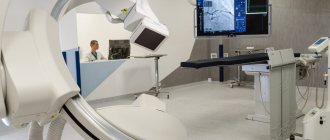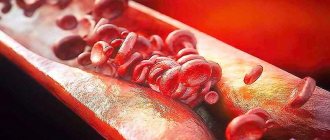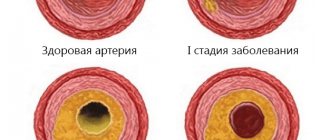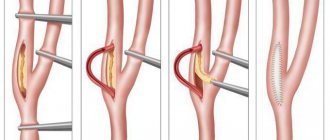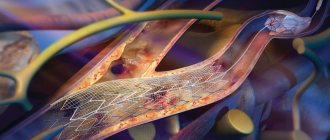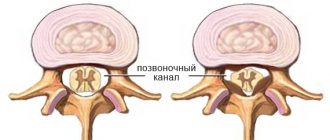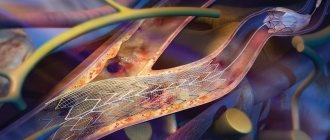Atherosclerosis
is a chronic disease characterized primarily by damage to medium and large arteries. On the inner walls of the arteries, fat deposits form in the form of atherosclerotic plaques, which can grow and block the lumen of the arteries - first partially, and in advanced cases, completely. As a result, the blood supply to the organs to which the artery leads is disrupted. The consequences of atherosclerosis are very serious and can be life-threatening. Atherosclerosis is the cause of coronary heart disease, heart attacks and strokes, and gangrene.
Causes of atherosclerosis
It has been established that the following factors favor the development of atherosclerosis:
- smoking. Nicotine and tars contained in tobacco have a negative effect on blood vessels;
- physical inactivity (maintaining a sedentary lifestyle);
- unbalanced diet, primarily abuse of fatty and cholesterol-rich foods;
- alcohol abuse;
- increased emotional reaction (susceptibility to stress);
- arterial hypertension;
- overweight (obesity);
- diabetes.
Factors contributing to the development of atherosclerosis also include the so-called non-modifiable factors (that is, factors that a person cannot do anything about):
- age (the risk group includes persons over 45 years old);
- gender (men are automatically at risk);
- presence in the family history of cases of early atherosclerosis.
Symptoms of atherosclerosis
Atherosclerosis begins unnoticed.
A person cannot feel that plaque has formed on the walls of the arteries until it has become a significant obstacle to blood flow. But with the help of instrumental diagnostics, atherosclerotic changes can be detected even at an early stage. Recent research shows that atherosclerotic artery disease can be found in most people aged 30 years and older. With age, the risk of developing atherosclerosis increases. At the same time, men suffer from atherosclerosis several times more often than women.
The manifestations of atherosclerosis vary depending on which arteries are most affected.
Atherosclerosis of the aorta
(the main vessel of the arterial system) usually leads to arterial hypertension (persistent increase in blood pressure). A characteristic sign is, first of all, an increase in systolic pressure (that is, the first, larger numerical indicator when measuring pressure).
Atherosclerosis of heart vessels
is the main cause of coronary heart disease (CHD). The most common form of coronary artery disease is angina pectoris, which manifests itself in the form of chest pain, usually of a pressing nature, as well as (in some cases) shortness of breath, weakness, and increased sweating. Atherosclerosis of the heart's own vessels can lead to the development of myocardial infarction, heart defects, and heart failure.
Atherosclerosis of cerebral vessels
may manifest itself with symptoms such as memory impairment, decreased attention, dizziness, tinnitus, and sleep disturbances. Complete closure of the vessel threatens ischemic stroke (death of part of the brain tissue due to impaired blood supply).
Symptom of atherosclerosis of the vessels of the lower extremities
is intermittent claudication. Intermittent claudication is pain in the calf muscles that causes you to stop walking. Once you stand and the pain goes away, you can continue to move on. Further development of the disease leads to pain in the calf muscles at rest and the appearance of trophic ulcers.
Atherosclerosis of the renal arteries
manifested by increased blood pressure (as well as atherosclerosis of the aorta).
Atherosclerosis of the arteries of the upper extremities
It is quite rare and manifests itself as weakness in one or both arms.
Atherosclerosis is a systemic disease, that is, if atherosclerotic lesions are detected in the arteries of one area, the development of atherosclerosis in other arteries is very likely.
Increased blood pressure
Manifests itself in atherosclerosis of the aorta
and
atherosclerosis of the renal arteries
.
Chest pain
It manifests itself in atherosclerosis of the heart vessels in the form of pain behind the sternum, usually of a pressing nature.
Dyspnea
Occurs in some cases with atherosclerosis of the heart vessels
.
More about the symptom
General weakness
Occurs in some cases with atherosclerosis of the heart vessels
. Weakness may be accompanied by increased sweating. The patient "breaks into a sweat."
Heartbeat disorders
Also for atherosclerosis of heart vessels
Heart rhythm disturbances may occur, so a feeling of accelerated or irregular heartbeat may also be a sign of atherosclerosis.
Memory impairment
Impaired brain activity may manifest itself in the form of memory loss or decreased ability to concentrate.
Dizziness
Dizziness may be one of the symptoms of cerebral atherosclerosis
.
Noise in ears
Manifests itself in cerebral atherosclerosis
.
More about the symptom
Sleep disorders
May be observed in cerebral atherosclerosis
.
More about the symptom
Intermittent claudication
Manifests itself in atherosclerosis of the vessels of the lower extremities
. The patient is forced to stop while walking due to pain in the calf muscles. In order to continue moving, you need to stand in one place and wait until the pain goes away.
Weakness in the hands
Weakness in one or both arms may indicate atherosclerosis of the arteries of the upper extremities
.
Methods for diagnosing atherosclerosis
Starting from the age of 45, it is advisable to undergo annual preventive examinations, especially for men.
Laboratory and instrumental studies are used to diagnose atherosclerosis.
The earlier the disease is detected, the lower the risk of complications. Effective treatment can slow down the development of atherosclerosis and improve the patient's condition. To undergo an initial examination, you can contact, first of all, a general practitioner (general practitioner or family doctor), as well as a cardiologist (if you are worried about your heart) or a neurologist (if you have neurological symptoms - memory impairment, dizziness, decreased attention, sleep disorders ).
Laboratory diagnostics
"Family Doctor" offers to use the laboratory profile "Diagnostics of atherosclerosis", which includes the necessary types of tests.
ECG
In the diagnosis of atherosclerosis, ECG is used in conjunction with other instrumental studies. As a basic cardiac procedure, the ECG usually precedes other diagnostic tests.
More information about the diagnostic method
Echocardiography
Echocardiography is an informative method of instrumental examination of the heart and coronary vessels using ultrasound. Echocardiography (Echo CG) makes it possible to assess in real time the nature of damage to the walls of the coronary vessels, the presence of blood clots in them, as well as the speed of blood flow. Used to diagnose atherosclerosis of the coronary vessels.
More information about the diagnostic method
Ultrasound Dopplerography of blood vessels
Ultrasound Dopplerography of vessels allows you to determine their diameter, wall thickness, identify intraluminal formations (atherosclerotic plaques, blood clots), assess the condition of venous valves, and detect blood flow disorders. Depending on the situation, ultrasound examination of vessels of various locations (cerebral vessels, brachiocephalic arteries, vessels of the lower or upper extremities, renal arteries) is performed.
Angiography
The essence of the angiography method is that a radiopaque substance is injected into the circulatory system, which makes it possible to visualize blood flow in problem vessels.
To diagnose the condition of the heart, aorta and its large branches, radiography, computed tomography and MRI examination of the chest organs can be used.
Sign up for diagnostics To accurately diagnose the disease, make an appointment with specialists from the Family Doctor network.
Treatment of carotid artery stenosis
The most common treatment for stenosis is artery stenting. Stenting is a surgical treatment method, therefore, like any other surgical intervention, it requires a highly qualified doctor in diagnosis, deciding on the need/possibility of surgery and direct insertion of the stent. A stent is a metal frame inserted directly into an artery. At the point of narrowing, it unfolds and expands the walls of the vessel as necessary. The stent remains in the artery. Only in the first days its presence can be inconvenient due to changes in blood flow, but over time the patient stops feeling it and returns to normal life without the risk of a stroke. But of course, the doctor will give certain recommendations for further lifestyle in order to prevent re-stenosis.
Our doctors understand the importance of high-quality patient management and postoperative monitoring, so by contacting us, you can count on an integrated approach to diagnosis, treatment and the postoperative period. To implement this approach, the neurology department of the Federal Scientific Research Center has a powerful diagnostic base and a strong team of specialists with extensive experience in the treatment of stenosis, who additionally undergo advanced training courses on a regular basis. The department closely cooperates with the cardiac surgery service and the department of vascular surgery, which is separated into a separate unit.
The advantage of our center is the provision of a full range of services to our patients in one place, starting with an initial consultation, which you can sign up for by phone or through a special form on the website.
Treatment methods for atherosclerosis
Effective treatment of atherosclerosis must be comprehensive and include both drug and non-drug methods.
Drug therapy
Drug treatment for atherosclerosis is primarily aimed at reducing the synthesis of cholesterol by the patient’s body, reducing its intracellular content, enhancing the removal of cholesterol and its metabolites from the body, and inhibiting the absorption of cholesterol in the intestine.
Non-drug treatments
Non-drug treatment of atherosclerosis is aimed at eliminating modifiable factors of the disease. First of all, this:
- quitting smoking and alcohol abuse;
- normalization of body weight;
- proper nutrition. It is necessary to reduce the consumption of foods high in cholesterol (it is advisable to avoid fatty and fried foods). The optimal menu should contain a significant amount of vegetables and fruits rich in fiber and vitamins. And meat can (and should) be replaced with fish;
- increasing physical activity. Physical activity is necessary, but it must be dosed (agreed with your doctor). It is also important to ensure that the body receives enough oxygen (it is optimal to exercise in the fresh air);
- exclusion of conflict situations and overwork (anti-stress psychotherapy).
Make an appointment Do not self-medicate. Contact our specialists who will correctly diagnose and prescribe treatment.
Rate how useful the material was
thank you for rating
Treatment of cholesterol plaques on the neck
The method of treating cholesterol plaques in the vessels of the neck is determined by the stage of the disease. It is customary to distinguish several stages of atherosclerosis: at the first - when conservative (non-invasive, i.e. not requiring surgical intervention) methods for removing cholesterol plaques remain effective - fatty plaque forms on the inner walls of blood vessels, and lipids penetrate into the damage to the endothelium. The body reacts to the latter by producing antibodies (macrophages), which “stick around” the lipid formation, gradually forming a plaque.
At the first stage, there may be treatment of cholesterol plaques in the carotid artery through specialized diets for high blood cholesterol levels, exercise, taking drugs to lower blood cholesterol levels (statins), the use of folk remedies and dietary supplements (dietary supplements) based on omega- 3 acids and linseed oil. Fatty plaque in the carotid artery can generally resolve on its own over time, without requiring any treatment. To do this, you should temporarily stop eating sweets, flour and fatty foods.
See also:
Flaxseed oil for atherosclerosis
Dietary supplements for atherosclerosis
Proper nutrition menu for high cholesterol
How to treat cholesterol plaque on the carotid artery at the second stage? The second stage means the formation of fibrin threads (“bridges” of connective tissue) between individual atherosclerotic deposits - it is not always impossible to treat cholesterol plaques that have undergone fibrosis without surgical intervention (it is possible to stop the condition and achieve partial regression of the plaque by taking cholesterol pills). On the other hand, cholesterol plaques in the carotid artery may not require treatment - they can grow to a certain point, after which they enter the stage of zero activity.

